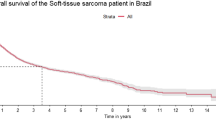Abstract
Details of sex, age at presentation and anatomical site of sarcoma complicating Paget's disease of bone were recorded from the literature for white patients in Australia, the United Kingdom and the United States over the period 1978--77. Evidence is presented to suggest that sex and tumour-site distributions are free from bias, except possibly for the skull. There was a male predominance for all sites except the skull, where the odds ratio of sarcoma compared with other locations is more than twice as high for females as for males. No national differences emerged in the sex ratio of patients. In Australia a latitudinal effect was observed. Whereas the percentage of males with uncomplicated Paget's disease was essentially constant, those with sarcoma showed a decrease with increase in latitude from Queensland to Victoria. This was attributable to tumours of the skull. Patients with bone involvement above the waist were significantly younger than those with affected feet, legs or pelvic girdle.
This is a preview of subscription content, access via your institution
Access options
Subscribe to this journal
Receive 24 print issues and online access
$259.00 per year
only $10.79 per issue
Buy this article
- Purchase on Springer Link
- Instant access to full article PDF
Prices may be subject to local taxes which are calculated during checkout
Similar content being viewed by others
Rights and permissions
About this article
Cite this article
Brackenridge, C. A statistical study of sarcoma complicating Paget's disease of bone in three countries. Br J Cancer 40, 194–200 (1979). https://doi.org/10.1038/bjc.1979.166
Issue Date:
DOI: https://doi.org/10.1038/bjc.1979.166
This article is cited by
-
Degeneration of Paget’s disease into sarcoma: clinical and therapeutic influencing factors
La Chirurgia degli Organi di Movimento (2008)



